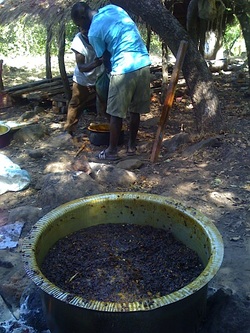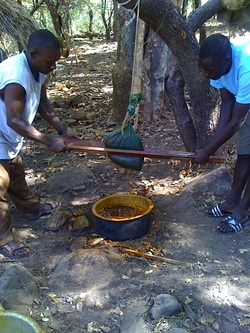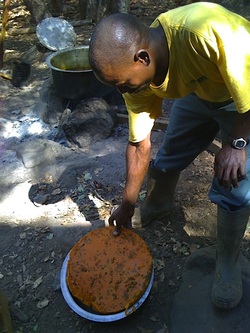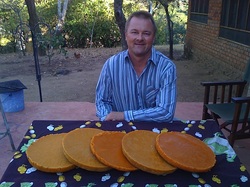Sixth Consideration: Rendering wax from comb
Wax is an important and valuable commodity from the bee hive. Bees wax is produced by bees themselves. When there is a nectar flow and honey stores are present in the bee hive, the bees secrete wax from 6 glands in their abdomen. These glands are called wax glands. Bees wax is produced in small cakes, which the bees chew and soften and then use to form their hexagonal cells. All bee combs are produced from bees wax. There is new white or yellow colored bee comb that is 100 percent wax, and brood comb that has had egg, pupa, larva, and baby bee residing in it. This brood comb has a cocoon spun inside of the wax comb by the developing bee. When boiling your wax for processing, you will notice many of these oval cups which are simply the cocoons that the bees have developed in. This will have to be discarded after your wax has been extracted. Organic bees wax is an important item and can be sold for around 4 dollars a kilogram. Wax is very much in demand for large and small industries in Africa and abroad.
Wax Rendering Process

Step 1
Fill a large pot half-way with water and add all your squeezed comb as well as brood comb. (Log hives typically produce the most wax.) Bring this to a boil until the comb has totally broken down, about a half hour.
Step 2

Take the boiled contents, pour it into a plastic (porous) grain bag and secure this bag to a tree branch with a rope. Use two strong durable boards to squeeze the mixture. This removes all the liquids. Thus water and melted wax will fall into the metal container underneath.
Step 3

The mixture will cool, allowing you to remove the hardened, separated wax from the top, leaving the water in the bottom of the container. You may now melt this wax and strain it to produce pure clean bees wax!
Step 4

The finished product. Pure clean wax!
Note: Be sure that your form holding the hot wax will release the wax poured into it after it hardens. You should use a plastic or flexible form and let your wax cool slightly before pouring it in. A thin coat of cooking oil or spray of silicone will help it to release even better.
